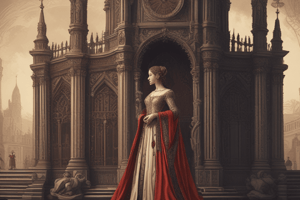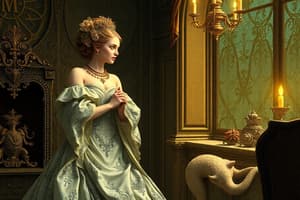Podcast
Questions and Answers
Which of the following is NOT a theme explored in The Duchess of Malfi?
Which of the following is NOT a theme explored in The Duchess of Malfi?
- Fate and destiny (correct)
- Justice and revenge
- Power and ambition
- Love and societal restrictions
How does the play use soliloquies?
How does the play use soliloquies?
- To summarize past events and provide exposition of the play's historical context.
- To create comedic relief and introduce new characters.
- To directly address the audience and break the fourth wall.
- To provide insights into the characters' inner thoughts and motivations. (correct)
Which of the following techniques contributes to the play's suspense and dramatic irony?
Which of the following techniques contributes to the play's suspense and dramatic irony?
- Extended monologues by minor characters.
- Use of metaphors and similes.
- Detailed descriptions of the setting and the characters' physical appearance.
- The use of dramatic irony. (correct)
The play's language is described as being:
The play's language is described as being:
How does The Duchess of Malfi demonstrate the corrupting influence of power and ambition?
How does The Duchess of Malfi demonstrate the corrupting influence of power and ambition?
What is a key factor contributing to the enduring appeal of The Duchess of Malfi?
What is a key factor contributing to the enduring appeal of The Duchess of Malfi?
What is a major difference between the love depicted in The Duchess of Malfi and the societal expectations of the time?
What is a major difference between the love depicted in The Duchess of Malfi and the societal expectations of the time?
How does the play The Duchess of Malfi influence later plays and theatrical tradition?
How does the play The Duchess of Malfi influence later plays and theatrical tradition?
What is the central tragic flaw that leads to the Duchess of Malfi's destruction?
What is the central tragic flaw that leads to the Duchess of Malfi's destruction?
Which character serves as a catalyst, exposing the darker aspects of human nature, while also representing the corrupting influence of ambition?
Which character serves as a catalyst, exposing the darker aspects of human nature, while also representing the corrupting influence of ambition?
What does the play The Duchess of Malfi satirize?
What does the play The Duchess of Malfi satirize?
Which element of the text best embodies the tension between the Catholic and Protestant faiths of the Jacobean era?
Which element of the text best embodies the tension between the Catholic and Protestant faiths of the Jacobean era?
Through its exploration of the Duchess's tragic fate, what does the play ultimately suggest about the social norms of the Jacobean era?
Through its exploration of the Duchess's tragic fate, what does the play ultimately suggest about the social norms of the Jacobean era?
Which of the following best reflects the moral compass of the old servants in The Duchess of Malfi?
Which of the following best reflects the moral compass of the old servants in The Duchess of Malfi?
What is the symbolic significance of the Duchess of Malfi embracing her lover Antonio when she is about to be murdered?
What is the symbolic significance of the Duchess of Malfi embracing her lover Antonio when she is about to be murdered?
Which of the following elements of the play reflects the power struggles and societal anxieties of the Jacobean era?
Which of the following elements of the play reflects the power struggles and societal anxieties of the Jacobean era?
Flashcards
John Webster
John Webster
Jacobean playwright known for The Duchess of Malfi
The Duchess of Malfi
The Duchess of Malfi
A wealthy woman defying societal norms for love
Ferdinand and the Cardinal
Ferdinand and the Cardinal
The Duchess's corrupt brothers driven by ambition
Antonio
Antonio
Signup and view all the flashcards
Bosola
Bosola
Signup and view all the flashcards
Tragedy and Fate
Tragedy and Fate
Signup and view all the flashcards
Corruption and Hypocrisy
Corruption and Hypocrisy
Signup and view all the flashcards
Love and Passion
Love and Passion
Signup and view all the flashcards
Passionate Love vs. Arranged Marriage
Passionate Love vs. Arranged Marriage
Signup and view all the flashcards
Justice and Revenge
Justice and Revenge
Signup and view all the flashcards
Power and Ambition
Power and Ambition
Signup and view all the flashcards
Imagery and Symbolism
Imagery and Symbolism
Signup and view all the flashcards
Use of Soliloquies
Use of Soliloquies
Signup and view all the flashcards
Dramatic Irony
Dramatic Irony
Signup and view all the flashcards
Language and Dialogue
Language and Dialogue
Signup and view all the flashcards
Legacy of The Duchess of Malfi
Legacy of The Duchess of Malfi
Signup and view all the flashcards
Study Notes
Author and Context
- John Webster, a Jacobean playwright, authored The Duchess of Malfi in the early 17th century.
- The play reflects the social and religious anxieties of the era, including tensions between Catholics and Protestants.
- Concerns about ambition, corruption, and power are central to the play's thematic framework.
Plot Summary
- The play revolves around the Duchess of Malfi, a wealthy and beautiful woman who secretly desires to marry for love rather than political gain.
- Her brothers, Ferdinand and the Cardinal, oppose her choice, fearing it will jeopardize their inheritance.
- The Duchess's defiance of societal norms leads to tragic consequences, culminating in her secret marriage and subsequent murder.
- The events expose the hypocrisy and cruelty of those in power.
Characters
- The Duchess of Malfi: A passionate and intelligent woman yearning for freedom from societal expectations.
- Tragic flaw: Her intense desire for happiness ultimately leads to destruction.
- Ferdinand and the Cardinal brothers: Driven by ambition and greed, they represent the corrupting influence of power, working to maintain their status.
- Antonio: The Duchess's lover, representing honesty and a contrast to the calculated machinations of other characters.
- Bosola: A morally ambiguous catalyst for the play. He exposes the darker aspects of human nature, embodying the corrupting influence of ambition.
- The Old Servant (and other servants): Often wise and morally upright, providing a counterpoint to the cruelty of the main characters, acting as narrators and offering critical perspectives.
Themes
- Tragedy and Fate: The play explores the inevitability of tragic consequences when one challenges societal norms.
- Corruption and Hypocrisy: The play critiques the corruption embedded within the ruling class, highlighting their hypocrisy and self-serving actions.
- Love and Passion: The Duchess's yearning for love and freedom contrasts with societal pressure to marry for political advantage.
- Justice and Revenge: The play explores the themes of retribution and societal expectations regarding morality and punishment.
- Power and Ambition: The play delves into the corrupting influence of ambition on human nature through the brothers and Bosola's actions.
Style and Language
- Imagery and Symbolism: Vivid imagery and symbolism convey the themes of ambition, corruption, and tragedy. Atmosphere and foreshadowing are crucial components of the narrative.
- Soliloquies: Soliloquies offer crucial insights into characters' motivations, plot development, and thematic exploration.
- Dramatic Irony, Tension, and Suspense: Dramatic irony builds tension and suspense, highlighting the Duchess's tragic fate and underlying meanings behind actions.
- Language and Dialogue: Rich and evocative language enhances the emotional impact. Dialogue unveils character motivations and builds suspense, contributing to the play's complexity.
Significance and Legacy
- Influence on Later Plays: The Duchess of Malfi influenced later playwrights and theatrical tradition, especially in its exploration of societal critique and power dynamics.
- Exploration of Human Nature: The play offers a profound look into the complexities of human nature, delving into ambition, corruption, and the struggle against societal constraints.
- Modern Relevance: The play's appeal lies in the timeless exploration of social inequality, individual struggles against established norms, and the consequences of unchecked ambition—all of which continue to resonate with contemporary audiences.
Studying That Suits You
Use AI to generate personalized quizzes and flashcards to suit your learning preferences.




